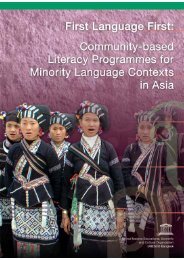Part II.pdf - MTB-MLE Network
Part II.pdf - MTB-MLE Network
Part II.pdf - MTB-MLE Network
You also want an ePaper? Increase the reach of your titles
YUMPU automatically turns print PDFs into web optimized ePapers that Google loves.
– learners will be able to read simple articles, write practical notes, and do some<br />
simple calculation using written Lahu. Lahu people will be encouraged to use<br />
written Lahu as much as possible and build their confidence in their written language;<br />
– learners will learn new income generating techniques and some basic marketing<br />
skills through using the La-Han bilingual learning materials;<br />
– dependent on the community context, local learning resources will be mobilized<br />
and community bilingual teachers will be encouraged to develop La-Han bilingual<br />
learning materials closely related to the daily life of Lahu illiterate learners.<br />
Teaching/learning content<br />
The teaching/learning content is closely connected with the learners’ lives and was chosen after<br />
a thorough analysis of the felt needs of the learners and the potential contribution of the learning<br />
materials to the development of the target communities. The localised learning materials are the<br />
main content of learning and teaching. Of course, the teaching may not necessarily follow the<br />
sequence of the materials, and can be responsive to the context. For example, if there are many<br />
people suffering from diarrhoea in a special period of the year, lectures on diarrhoea prevention<br />
and treatment can be held for the learners.<br />
Learning materials<br />
The main learning materials have been developed in response to the needs of the target communities.<br />
The literacy teachers will also use pictures, audio-visual materials on farming technology and some<br />
materials developed by local educational agencies.<br />
Teaching patterns<br />
Class teaching is the main approach of the literacy class. There are other techniques practiced<br />
such as site teaching, field visits, using VCD’s, case teaching, group work, discussion, recreation<br />
and sports activities.<br />
Like other ethnic groups in China, Lahu people like singing and dancing, especially during their<br />
traditional festivals. The community learning centres have organized many recreational and sports<br />
activities, and the target learners are willing to come and learn. Some of the literacy activities in<br />
Nanuoke and Banli are integrated with the activities mentioned above. Local traditions, legends,<br />
folk songs and dancing have been adapted and adopted into the literacy programme. This can improve<br />
their personal identity, as the teaching resource originates from a world with which they are familiar.<br />
7. Innovative Bilingual Literacy Activities<br />
La-Han bilingual learning material<br />
Without mastering the writing system of the Lahu language, it is difficult for the Lahu people to<br />
learn Chinese. In order to solve this problem, the research group thought that it was important to<br />
develop Lahu-Han bilingual functional literacy materials that put particular stress on Lahu. Before<br />
163
















